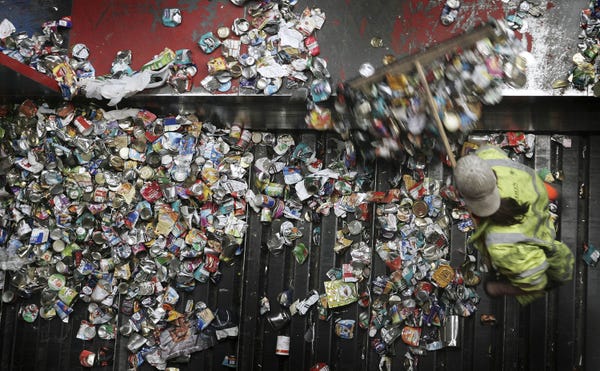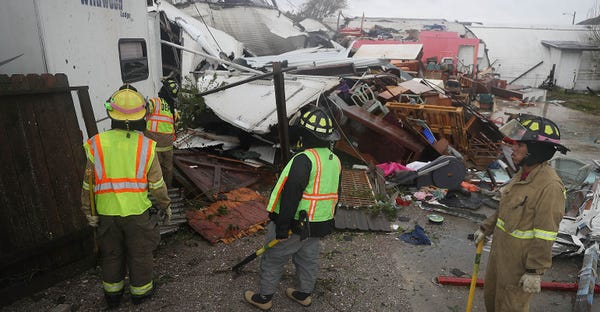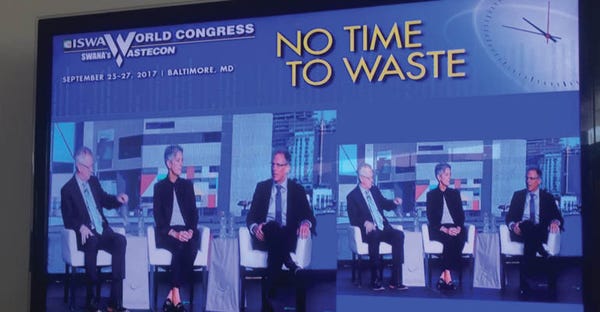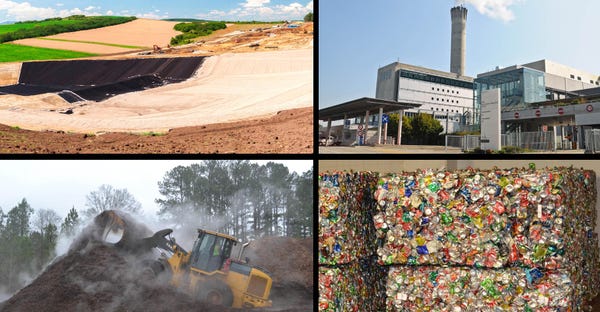Industry Experts Share 2017 Highlights, 2018 Predictions
As we approach a new year, Waste360 spoke with a number of industry experts to highlight some of the top moments of 2017 and some of the predictions for 2018.

The waste and recycling industry started 2017 off strong, with commodity prices up from the year prior and the solid waste index once again beating the market. In fact, solid waste remained on a path to meet or exceed fiscal year 2017 expectations of core price, with reported price with volume growth bouncing around due to the hurricanes and special waste activity, according to Stifel analyst Michael E. Hoffman.
That positive streak slowed down in the second half of the year, however, when China threw a monkey wrench into the works by announcing its National Sword policy, which aims to ban 24 types of solid waste from entering the country.
“Up until those announcements from China, things were looking much better for the industry in 2017 compared to 2016,” says Joe Pickard, chief economist at the Institute of Scrap Recycling Industries (ISRI). “A lot of our member companies are small- and medium-sized businesses, and they were really enthused about what they were hearing from the incoming administration about the tax reform bill, reforming healthcare, reducing regulatory burdens and improving infrastructure. But, unfortunately, not a lot of progress has been made for a number of those areas.”
As we approach a new year, Waste360 spoke with a number of industry experts to highlight some of the top moments of 2017 and some of the predictions for 2018.
Looming Chinese Waste Import Ban Raises Concerns
In July, China registered two filings with the World Trade Organization (WTO), signaling its intent to forbid 24 types of solid wastes by the end of this year. And in November, China’s Ministry of Environmental Protection laid out a standard of 0.5 percent contamination for various materials, including scrap plastics and paper, which is a slight relaxation from its initial proposal of 0.3 percent contamination standard for all materials.
These actions sparked a reaction from the waste and recycling industry, which has been pushing back against the National Sword policy for months now. Some of the active industry associations stepping up to submit comments to the WTO on behalf of the industry include the Institute of Scrap Recycling Industries (ISRI), the National Waste & Recycling Association (NWRA) and the Solid Waste Association of North America (SWANA). All three associations submitted comments directly after China’s initial filings in July and then again last week in response to the country’s amended proposed contamination standards.
“China’s proposed waste import ban is the most important systemic issue the industry has dealt with this year, and I think it will be something that we continue to deal with in 2018 and years to follow,” says David Biderman, CEO and executive director of SWANA. “China’s interest in dramatically changing the terms upon which it’s willing to accept imported material from both the U.S. and Canada, as well as other locations, is having a very significant impact on recycling locations. It’s a very substantial change for our local governments and our industry partners to manage the material in the wake of these restrictions.”

In preparation of China’s waste import ban, materials management facility operators and recyclers in North America are working to make their material cleaner and finding other markets to enter, such as Southeast Asia, India and Latin America. Some are even looking domestically to avoid exporting materials altogether.
“China’s ban is resulting in a push to improve the quality of material in the recycling supply chain and to incentivize investment in recycling equipment and facilities in the U.S.,” says Joe Pickard, chief economist at IRSI. “China is going to demand high-quality, ferrous-ready material, and that material needs to be processed to a higher degree here in the U.S. before it gets shipped offshore.”
In addition to concerns about producing clean, high-quality materials, recyclers are concerned that trade investigations could trigger retaliatory protectionist trade measures overseas. Just last week, China announced that it’s going to reduce its export taxes on steel products, for example, which will make it easier for the country to export more steel products into the global marketplace in 2018.

“At SWANA, we don’t disagree with China’s goal of being more environmentally protective, but we think that the incredibly quick time period between the proposal and closing the door is unreasonable,” comments Biderman. “We would like to work with China to develop a mutual satisfactory timeline for these waste restrictions, and I am hopeful that the comments that we continue to file will either influence or have an impact on China’s waste import policy.”
While many questions are left unanswered right now regarding the waste import ban and the challenges and opportunities that may come along with that ban, industry leaders are working with China and each other to try to reach a common ground.
“We have our fingers crossed, but the reverberations from the constraints on recyclables will certainly continue in 2018,” says Darrell Smith, president and CEO of NWRA. “The downside is that the overall markets will decline as the end markets shrink, and the upside is that there will be a stronger market and demand for equipment manufacturers domestically. We’re hoping that China will work with us as partners to keep this very important market open.”
Smarter Technology Comes Online
This year was a groundbreaking year for technology in the waste and recycling industry, with new advancements being adapted in the truck and in recycling facilities. From robotics, advanced sensors and the Internet of Things to driverless trucks, drones and Internet-enabled cans, the industry as a whole has become smarter over the course of 2017.
“Technology continues to be an important facet of how the industry evolves on many different fronts,” says Bryan Staley, president and CEO of EREF. “There’s certainly been more automation and data collection at facilities and more management for collection this year, which has helped those in the industry make better business decisions.”
Technology has also played a role in improving safety, which is important to those in the industry because the waste and recycling industry is on the top 10 most dangerous jobs in the U.S. list. This year, new technologies and equipment have helped keep more employees and facilities safe.

“We’re seeing technology being used more than ever to reduce accidents and injuries, promote safety for the drivers and other collection employees, make material cleaner, monitor fixed facilities and identify issues in a way that’s both cost effective and less dangerous,” states Biderman. “This industry is not a one-size-fits-all industry, and it’s exciting to see how these technologies, especially driverless vehicles, are impacting various areas of the industry.”
Over the past couple of years, the industry, along with many other industries, has experienced a driver shortage. In fact, the shortage of qualified truck drivers is projected to hit an all-time high of 50,000 by the end of this year, according to Bob Costello, chief economist of American Trucking Associations. But with more and more driverless and autonomous vehicles being piloted and implemented, the driver shortage is easing slightly.
“Advancements in technology are automatic labor savers because they provide capital investment and reduce the number of people needed,” says Smith. “The driver shortage has eased a little bit with new technologies and equipment, but the limits on immigration and elimination of temporary protected status for some immigrant pools could exacerbate the issue.”
Technology is also improving operations at landfills, by allowing operators and engineers to monitor and manage greenhouse gas emissions via drones instead of mirrors, lasers and scissor jacks. Using drones saves time and money and ultimately produces more accurate detections.

Natural Disasters Present Opportunities and Challenges
While the industry is trained to prepare in advance for some natural disasters, others arise unexpectedly and require on-your-feet thinking at a moment’s notice. And that’s exactly that happened in the second half of 2017, when natural disasters struck areas like Texas, Florida, California and Puerto Rico.
From powerful hurricanes to raging wildfires, the waste and recycling industry teamed with the Environmental Protection Agency (EPA), the U.S. Army Corps of Engineers (USACE), local communities and emergency services personnel to assist with cleanup.
“Nobody expected or predicted the natural disasters of 2017,” comments Smith. “We’re going to continue to feel the impact of those natural disasters going into 2018 as the industry continues to clean up the waste and debris generated from those events.”

Many areas affected by this year’s natural disasters have completed the first round of cleanups, but there is still much work to be done to get these areas back to a livable condition. In Puerto Rico, an area that was hit the hardest, majority of residents and business are still without power and basic necessities like drinking water. The island is now running on 700 temporary generators until the power system is rebuilt and restored, which may not happen until summer 2018 or later.
In addition to that problem, the island is battling with managing the waste and debris generated by Hurricane Maria because its 29 landfills reached capacity over a year ago and are currently overflowing. To assist with resolving this issue, the USACE, the EPA, local contractors and a number of haulers are working together to separate hazardous waste from organic material and to clean up the massive amount of debris and waste produced by the hurricane.
Industry Associations Reach Milestones
Three of the leading industry associations, SWANA, NWRA and EREF, reported positive growth and highlights for 2017. From increased memberships to successful events to developing informational reports, these three associations had quite the year.
SWANA held its annual WASTECON event in Baltimore this year, which drew a highly unusual attendance, according to Biderman. This was partially driven by the fact that it was co-sited with the ISWA World Congress and that SWANA was able to develop more educational content that was attractive to both the domestic and international audience. Additionally, SWANA’s membership has grown to more than 9,600 members, and its safety program has improved this year.

NWRA welcomed Smith as its new president and CEO in the latter part of this year. And since then, Smith has been focusing on working through staffing issues, making the association more results oriented and less process oriented, developing a fluid and flexible work environment and creating five main working teams: state and chapter, federal, media and communications, technical and regulatory and memberships and meetings. He’s also been working on rebidding contracts, rethinking how the association manages some things and developing a balanced budget.
“We are proud to say that for the first time in over a decade, we have a balanced budget for the new year,” says Smith. “With that balanced budget, we will be able to devote more resources and funding toward developing industry programs and advocacy to make the industry stronger.”
EREF also had a productive year. It released its “MSW Management Facilities in the U.S.” report, which includes a complete list of the 9,028 facilities identified as managing municipal solid waste in 2010 and/or in 2013. And it released its analysis of municipal solid waste landfill tip fees, which reveals that the average tipping fee is increasing.
Additionally, EREF has continued to respond to industry needs through its core programs. One of its core programs involves funding academic institutions to address needs, and this year, EREF funded six new projects, bringing its total projects since inception to nearly 100. EREF also funded seven new scholars this year through its multiyear scholarship program, which helps students find jobs in the solid waste industry.

2018 Predictions
Looking forward to 2018, the waste and recycling industry will be faced with many challenges along with many opportunities. While China’s waste import ban remains top of mind, the passage of the $1.5 trillion U.S. tax reform bill is also something the industry is paying close attention to because it could lead to a significant increase in transactions in 2018 in addition to reducing corporate tax rates and allowing full expensing of some capital investments for the next five years.
“We remain optimistic that the tax reform bill will ... provide much-needed relief to the American industry,” says Smith.
The House voted 227-203 yesterday to approve the tax reform bill, and the Senate approved it late last night.
“Many people I’ve spoken with in the industry are pleased that the tax reform bill is being enacted, as it reduces corporate tax rates, allows full expensing of certain capital investments for the next five years and increases the cap on such expensing from $500,000 to $1 million,” says Biderman.
The industry is also keeping an eye out for progress with other government policies, such as potential additional changes in environmental rules and regulations made by the EPA, possible advancements on infrastructure spending by the Trump administration and further opportunities to clean up Superfund sites.

In addition to government policy, development of food waste reduction strategies, the use of smart technologies, the exploration of new performance metrics, finding new markets for the exportation of materials and the implementation of plastic bag bans round out the initial predictions for the new year.
As far as the state of solid waste goes, Hoffman predicts that the 2018 core solid waste organic growth should be 3 percent to 5 percent, the recycling growth should be 0.5 percent to 1.0 percent depending on the sales ratio and the topline growth should track at 1.0 percent to 6 percent. These numbers will be largely driven by population, gross domestic product (GDP), consumer sentiment and housing starts.
“In FY18, housing starts are expected to grow 60,000 to 70,000 and hold that pace, which means housing remains a catalyst for solid waste through 2020,” said Hoffman in a statement. “Overall annual population growth is around 0.7 percent, with regional differences ranging between 0.04 percent and 1.08 percent. GDP, which had languished at 4.1 percent to 3.3 percent from 2008 to 2016, picked up momentum in FY17 to 2.3 percent. Even without tax reform, GDP should hold in a 2.5 percent to 3.5 percent level driven by efforts to reduce burdensome regulation to the overall economy. The consumer remains engaged with sentiment favorable and shows no signs of a pullback.”
The associations have also teased what the industry can expect to see from them in 2018. NWRA will be working on membership growth, adding to its advocacy program and creating solid relationships with Congress and regulatory agencies. SWANA will continue to monitor the progression of China’s waste import ban and develop additional safety resources for the industry, with a goal of helping get the industry off the 10 most dangerous jobs in the U.S. list. EREF will publish an online textbook for solid waste that will be used by professors and universities across the U.S., focus on growing its new internship program for undergrads, expand its presence in Canada and conduct studies and develop informational reports on challenging areas like leachate treatment, elevated temperatures in landfills and management of special waste materials.
About the Author
You May Also Like




.png?width=300&auto=webp&quality=80&disable=upscale)